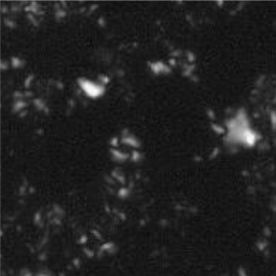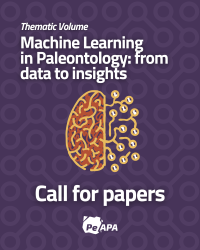ASSESSMENT OF BEST DATA SET FOR STATISTICAL ANALYSIS OF COCCOLITHOPHORE DISTRIBUTION IN THE ARGENTINA CONTINENTAL MARGIN
DOI:
https://doi.org/10.5710/PEAPA.04.02.2023.411Keywords:
Calcareous nannoplankton, Counting methodology, Data analysis, Surface sediment, Southwest Atlantic OceanAbstract
Coccolithophore thanatocoenosis from 33 surface sediment samples in the Argentina Continental Margin were analyzed. Emiliania huxleyi, the most ubiquitous species in today´s ocean, occurs at relative abundances higher than 60% and tends to obscure the variations in abundance of less represented species. This study aims to compare two intensively used counting methods in coccolithophore studies: including and excluding E. huxleyi from the data set and compare which of both methodologies better reflects the known oceanographic conditions in the area. In the two data sets, species abundances were converted to percentages and Clusters Analysis were performed. The result including E. huxleyi reveals two groups (A and B) separated of compositional Euclidean distance of 12.8. Group A is restricted to the southeastern area (near Malvinas Islands) and is dominated by Gephyrocapsa muellerae (> 56%). Group B is dominated by E. huxleyi (> 93%) and is distributed into two areas: in the southwest (near Tierra del Fuego) and in the north (between 40°S – 47°S). The result excluding E. huxleyi also shows two groups (A’ and B’) distant to a compositional Euclidean distance of 15.8. Group A’ has both a southern and northern distribution, whereas Group B’ is present only at the northern area. These two groups cannot be explained by the relation between the coccolithophore taxa dominance and the surface oceanographic conditions. Our results indicate that the inclusion of E. huxleyi is the most appropriate approach since it seems to better correlate with the known oceanographic regime in the Argentina Continental Margin.
References
Aitchison, J. (1986). The statistical analysis of compositional data. Chapman and Hall, London.
Aitchison, J. (1999). Logratios and natural laws in compositional data analysis. Mathematical Geology, 131, 563–580.
Aitchison, J., Barceló-Vidal, C., Martín-Fernández, J. A., & Pawlowsky-Glahn, V. (2000). Logratio analysis and compositional distance. Mathematical Geology, 32(3), 271–275.
Andruleit, H., von Rad, U., Bruns, A., & Ittekkot, V. (2000). Coccolithophore fluxes from sediment traps in the northeastern Arabian Sea off Pakistan. Marine Micropaleontology, 38, 285–308. http://dx.doi.org/10.1016/S0377-8398(00)00007-4.
Balch, W. M., Drapeau, D. T., Bowler, B. C., Lyczskowski, E., Lubelczyk, L. C., Painter, S. C., & Poulton, A. J. (2014). Surface biological, chemical and optical properties of the Patagonian Shelf coccolithophore bloom, the brightest waters of the Great Calcite Belt. Limnology and Oceanography, 59(5), 1715–1732. https://doi.org/10.4319/lo.2014.59.5.1715.
Baumann, K. H., Boeckel, B., & Cepek, M. (2008). Spatial distribution of living coccolithophores along an east-west transect in the subtropical South Atlantic. Journal of Nannoplankton Research, 30, 9–21. https://doi.org/10.1144/jmpaleo2011-007.
Benthien, A. & Müller, P. J. (2000). Anomalously low alkenone temperatures caused by lateral particle and sediment transport in the Malvinas Current region, western Argentine Basin. Deep-Sea Research I, 47, 2369–2393. https://doi.org/10.1016/S0967-0637(00)00030-3.
Bianchi, A. A., Giulivi, C. F., & Piola, A. R. (1993). Mixing in the Brazil–Malvinas Confluence. Deep–Sea Research, 40, 1345–1358. https://doi.org/10.1016/0967-0637(93)90115-J.
Bickert, T. & Wefer, G. (1996). Late Quaternary deep-water circulation in the South Atlantic: reconstructions from carbonate dissolution and benthic stable isotopes. In G. Wefer, W. H. Berger, G. Siedler, & D. J. Webb (Eds.), The South Atlantic: Present and past circulation (pp. 599–620). Springer–Verlag.
Boeckel, B. & Baumann, K. H. (2004). Distribution of coccoliths in surface-sediments of the south-eastern South Atlantic Ocean: ecology, preservation and carbonate contribution. Marine Micropaleontology, 51, 301–320. https://doi.org/10.1016/j.marmicro.2004.01.001.
Boeckel, B., Baumann, K. H., Henrich, R., & Kinkel, H. (2006). Coccolith distribution patterns in South Atlantic and Southern Ocean surface sediments in relation to environmental gradients. Deep-Sea Research I, 53, 1073–1099. https://doi.org/10.1016/j.dsr.2005.11.006.
Boltovskoy, E. (1970). Masas de agua (Características, distribución, movimientos) en la superficie del Atlántico sudeste según indicadores biológicos - Foraminíferos. Servicio de Hidrografía Naval H., 643, 1–99.
Boltovskoy, E. (1981). Masa de agua en el Atlántico Sudoccidental. In D. Boltovskoy (Ed.), Atlas de zooplancton del Atlántico Sudoccidental (pp. 227–236). Mar del Plata: Museo Argentino de Ciencias Naturales.
Boyer, T. P., Antonov, J. I., Baranova, O. K., Coleman, C., Garcia, H. E., Grodsky, A., Johnson, D. R., Locarnini, R. A., Mishonov, A. V., O’Brien, T. D., Paver, C. R., Reagan, J. R., Seidov, D., Smolyar, I. V., & Zweng, M. M. (2013). World Ocean Database 2013. NOAA Atlas NESDIS 72.
Bramlette, M. N. & Sullivan, F. R. (1961). Coccolithophorids and related nannoplankton of the Early Tertiary in California. Micropaleontology, 7, 129–188.
Brand, L. E. (1994). Physiological ecology of marine coccolithophores. In A. Winter, & W. G. Siesser (Eds), Coccolithophores (pp. 39–49). Cambridge University Press.
Buccianti, A. & Esposito, P. (2004). Insights into Late Quaternary calcareous nannoplankton assemblages under the theory of statistical analysis for compositional data. Palaeogeography, Paleoclimatology, Palaeoecology, 202, 209–227. https://doi.org/10.1016/S0031-0182(03)00635-7.
Charalampopoulou, A., Poulton, A. J., Bakker, D. C. E., Lucas, M. I., Stinchcombe, M. C., & Tyrrell, T. (2016). Environmental drivers of coccolithophore abundance and calcification across Drake Passage (Southern Ocean). Biogeosciences, 13, 5917–5935. https://doi.org/10.5194/bg-13-5917-2016.
Clifford, H. T. & Stephenson, W. (1975). An Introduction to Numerical Classification. Academic Press.
Dittert, N., Baumann, K. H., Bickert, R., Henrich, R., Huber, R., Kinkel, H., & Meggers, H. (1999). Carbonate dissolution in the deep-sea: methods, quantification and paleoceanographic application. In G. Fischer, & G. Wefer (Eds.), Use of Proxies in Paleoceanography: Examples from the South Atlantic (pp. 255–284). Springer Verlag.
Fatela, F. & Taborda, R. (2002). Confidence limits of species proportions in microfossil assemblages. Marine Micropaleontology, 45, 169–174. https://doi.org/10.1016/S0377-8398(02)00021-X.
Feely, R. A., Sabine, CH. L., Takahashi, T., & Wanninkhof, R. (2001). Uptake and storage of carbon dioxide in the ocean: The Global CO2 Survey. U. S. Joint Global Ocean Flux Study, Special Issue, 14, 18–32.
Franco, B. C., Piola, A. R., Rivas, A. L., Baldoni, A. & Pisoni, J. P. (2008). Multiple thermal fronts near the Patagonian shelf break. Geophysical research letters, 35, L02607. https://doi.org/10.1029/2007GL032066.
Giraudeau, J. (1992). Distribution of recent nannofossils beneath the Benguela system: southwest African continental margin. Marine Geology, 108, 219–237. https://doi.org/10.1016/0025-3227(92)90174-G.
Giraudeau, J. & Rogers, J. (1994). Phytoplankton biomass and sea-surface temperature estimates from sea-bed distribution of nannofossils and planktonic foraminifera in the Benguela upwelling system. Micropaleontology, 40 (3), 275–285. https://doi.org/10.2307/1485822.
Gordon, A. L. (1989). Brazil-Malvinas confluence-1984. Deep-Sea Research, 36, 359–384. https://doi.org/10.1016/0198-0149(89)90042-3.
Haidar, A. T. & Thierstein, H. R. (2001). Coccolithophore dynamics off Bermuda (North Atlantic). Deep-Sea Research II, 48, 1925–1956. https://doi.org/10.1016/S0967-0645(00)00169-7.
Hammer, Ø., Harper, D. A., & Ryan, P. D. (2001). PAST: Paleontological statistics software package for education and data analysis. Palaeontologia electronica, 4(1), 9.
Heaton, T. J., Köhler, P., Butzin, M., Bard, E., Reimer, R. W., Austin, W. E. N., Bronk Ramsey, C., Grootes, P. M., Hughen, K. A., Kromer, B., Reimer, P. J., Adkins, J., Burke, A., Cook, M. S., Olsen, J., & Skinner, L. C. (2020). Marine20 - the marine radiocarbon age calibration curve (0-55,000 cal BP). Radiocarbon 62, 779–820. https://doi.org/10.1017/RDC.2020.68.
Hernández-Molina, F. J., Paterlini, M., Somoza, L., Violante, R., Arecco, M. A., de Isasi, M., Rebesco, M., Uenzelmann-Neben, G., Neben, S. & Marshall, P. (2010). Giant mounded drifts in the Argentine Continental Margin: Origins, and global implications for the history of thermohaline circulation. Marine and Petroleum Geology, 27, 1508–1530.
Hine, N. & Weaver, P. P. E. (1998). Quaternary. In P. R., Bown (Ed.), Calcareous Nannofossil Biostratigraphy (pp. 265–278). Chapman & Hall.
Holligan, P. M., Charalampopoulou, A., & Hutson, R. (2010). Seasonal distributions of the coccolithophore, Emiliania huxleyi, and of particulate inorganic carbon in surface waters of the Scotia Sea. Journal of Marine Systems, 82(4), 195–205.
Jordan, R., Cros, L. & Young, J. (2004). A revised classification scheme for living haptophytes. Micropaleontology, 50, 55–79.
Knappertsbusch, M., Cortes, M. Y., & Thierstein, H. R. (1997). Morphologic variability of the coccolithophorid Calcidiscus leptoporus (Murray and Blackman) Loeblich and Tappan during the Holocene and early Pleistocene. Marine Micropaleontology, 30, 293–317. https://doi.org/10.1016/S0377-8398(96)00053-9.
Martín-Fernández, J. A., Barceló-Vidal, C., & Pawlowsky-Glahn, V. (1998). Measures of Difference for Compositional Data and Hierarchical Clustering Methods. In A., Buccianti, G., Nardi, & R. Potenza (Eds.), Proceedings of the Fourth Annual Conference of the International Association for Mathematical Geology (pp. 526–531). De Frede.
Martín-Fernández, J. A., Barceló-Vidal, C., & Pawlowsky-Glahn, V. (2003). Dealing with zeros and missing values in compositional data sets using nonparametric imputation. Mathematical Geology, 35(3), 253–278. https://doi.org/10.1023/A:1023866030544.
Martínez-Sánchez, M., Flores, J.-A., Palumbo, E., Alonso-Garcia, M., Sierro, F.-J. & Amore, F. O. (2019). Reconstruction of surface water dynamics in the North Atlantic during the Mid-Pleistocene (~540–400 ka), as inferred from coccolithophores and planktonic foraminifera. Marine Micropaleontology, 152, 101730.
Matano, R. P. (1993). On the separation of the Brazil Current from the coast. Journal of Physical Oceanography, 23(1), 79–90. https://doi.org/10.1175/1520-0485(1993)023<0079:OTSOTB>2.0.CO;2.
Matano, R. P. & Palma, E. D. (2008). On the upwelling of downwelling currents. Journal of Physical Oceanography, 38(11), 2482–2500. https://doi.org/10.1175/2008JPO3783.1.
Matano, R. P., Palma, E. D., & Piola, A. R. (2010). The influence of the Brazil and Malvinas Currents on the southwestern Atlantic shelf circulation. Ocean Science, 6(4), 983–995. https://doi.org/10.5194/os-6-983-2010.
McIntyre, A. & Bé, A. W. H. (1967). Modern Coccolithophoridae of the Atlantic Ocean - I. Placoliths and Cyrtoliths. Deep Sea Research and Oceanographic Abstracts, 14, 561–579.
Miller, R. N., Matano, R. P., & Palma, E. D. (2011). Shelfbreak upwelling induced by alongshore currents: analytical and numerical results. Journal of Fluid Mechanics, 686, 239–249. https://doi.org/10.1017/jfm.2011.326.
Mollenhauer, G., McManus, J. F., Benthien, A., Müller, P. J., & Eglinton, T. I. (2006). Rapid lateral particle transport in the Argentine Basin: molecular 14C and 230Thxs evidence. Deep-Sea Research I, 53, 1224–1243. https://doi.org/10.1016/j.dsr.2006.05.005.
Monechi, S., Buccianti, A., & Gardin, S. (2000). Biotic signals from nannoflora across the iridium anomaly in the upper Eocene of the Massignano section: evidence from statistical analysis. Marine Micropaleontology 39, 219–237. https://doi.org/10.1016/S0377-8398(00)00022-0.
Mostajo, E. L. (1986). La tanatocenosis de cocolitofóridos como indicadores biológicos de masas de aguas superficiales. Neotrópica 32, 167–170.
Okada, H. & McIntyre, A. (1977). Modern coccolithophores of the Pacific and the North Atlantic Oceans. Micropaleontology, 23, 1–55.
Okada, H. & McIntyre, A. (1979). Seasonal distribution of modern coccolithophores in the western North Atlantic Ocean. Marine Biology, 54, 319–328. http://doi.org/10.1007/
BF00395438.
Peterson, R. G. & Stramma, L. (1991). Upper-level circulation in the South Atlantic Ocean. Progress in Oceanography, 26, 1–73.
Piola, A. R., Avellaneda, N. M., Guerrero, R. A., Jardón, F. P., Palma, E. D., & Romero, S. I. (2010). Malvinas-slope water intrusions on the northern Patagonia continental shelf. Ocean Science, 6(1), 345–359. https://doi.org/10.5194/os-6-345-2010.
Piola, A. R. & Matano, R. P. (2001). Brazil and Falklands (Malvinas) currents. In J. H., Steele, S. A. Thorpe, & K. K. Turekian (Eds.), Encyclopedia of ocean sciences (pp. 340–349). London, Academic Press, vol. 1.
Piola, A. R. & Matano, R. P. (2017). Ocean Currents: Atlantic Western Boundary–Brazil Current/Falkland (Malvinas) Current. Reference Module in Earth Systems and Environmental Sciences. Elsevier. https://doi.org/10.1016/B978-0-12-409548-9.10541-X.
Poulton, A. J., Painter, S. C., Young, J. R., Bates, N. R., Bowler, B., Drapeau, D., Lyczsckowski, E., & Balch, W. M. (2013). The 2008 Emiliania huxleyi bloom along the Patagonian Shelf: ecology, biogeochemistry, and cellular calcification. Global Biogeochemical Cycles, 27, 1–11. https://doi.org/10.1002/2013GB004641.
Poulton, A. J., Young, J., Bates, N., & Balch, W. M. (2011). Biometry of detached Emiliania huxleyi coccoliths along the Patagonian shelf. Marine Ecology Progress Series, 443, 1–17. https://doi.org/10.3354/meps09445.
Romero, S. L., Piola, A. R., Charo, M., & Garcia, C. E. (2006). Chlorophyll-a variability off Patagonia based on SeaWiFS data. Journal of Geophysical Research, 111, C05021. https://doi.org/10.1029/2005JC003244.
Roth, P. H. & Berger, W. H. (1975). Distribution and dissolution of coccoliths in the south and central Pacific. Cushman Foundation for Foraminiferal Research Special Publication, 13, 87–113.
Rühlemann, C. & Butzin, M. (2006). Alkenone temperature anomalies in the Brazil-Malvinas Confluence area caused by lateral advection of suspended particulate material. Geochemistry Geophysics Geosystems, 7, Q10015. https://doi.org/10.1029/2006GC001251.
Ryan, W. B. F., Carbotte, S. M., Coplan, J. O., O’Hara, S., Melkonian, A., Arko, R., Weissel, R. A., Ferrini, V., Goodwillie, A., Nitsche, F., Bonczkowski, J., & Zemsky, R. (2009). Global Multi-Resolution Topography synthesis. Geochemistry, Geophysics, Geosystems 10(3), Q03014. https://doi.org/10.1029/2008GC002332.
Saavedra-Pellitero, M. & Baumann, K. H. (2015). Comparison of living and Surface sediment coccolithophore assemblages in the Pacific sector of the Southern Ocean. Micropaleontology, 61, 507–520.
Saavedra-Pellitero, M., Baumann, K. H., Hernández-Almeida, I., Flores, J., & Sierro, F. (2013). Modern sea surface productivity and temperature estimations off Chile as detected by coccolith accumulation rates. Palaeogeography, Palaeoclimatology, Palaeoecology, 392, 534–545. https://doi.org/10.1016/j.palaeo.2013.10.010.
Schlitzer, R. (2015). Ocean Data View, available at: https://odv.awi.de/ (last access: 01 August 2019).
Steinmetz, J. C. (1994). Sedimentation of coccolithophores. In A. Winter, & W.G. Siesser (Eds.), Coccolithophores (pp. 179–197). Cambridge University Press.
Stuiver, M. & Reimer, P. J. (1993). Radiocarbon, 35, 215–230.
Thierstein, H. R. (1980). Selective dissolution of Late Cretaceous and earliest tertiary calcareous nannofossils: experimental evidence. Cretaceous Research, 2, 165–176. https://doi.org/10.1016/0195-6671(80)90023-3.
Thierstein, H. R., Geitzenauer, K. R., Molfino, B., & Shackleton, N. (1977). Global Synchroneity of The Late Quaternary coccolith datum levels: validation by oxygen isotopes. Geology, 5, 400–404. https://doi.org/10.1130/0091-7613(1977)5<400:GSOLQC>2.0.CO;2.
Vink, A. (2004). Calcareous dinoflagellate cysts in South and equatorial Atlantic surface sediments: diversity, distribution, ecology and potential for palaeoenvironmental reconstruction. Marine Micropaleontology, 50, 43–88. https://doi.org/10.1016/S0377-8398(03)00067-7.
Violante, R. A., Laprida, C., & García Chapori, N. (2017). The Argentina Continental Margin: a potential Paleoclimatic-Paleoceanographic archive for the Southern Ocean. Springer Briefs in Earth System Sciences. Springer, Dordretch. https://doi.org/10.1007/978-3-319-04196-4.
Winter, A., Jordan, R. W., & Roth, P. (1994). Biogeography of living coccolithophores in ocean waters. In A. Winter, & W. G. Siesser (Eds.), Coccolithophores (pp. 161–177). Cambridge University Press.
Winter, A., Reiss, Z., & Luz, B. (1979). Distribution of living coccolithophore assemblages in the Gulf of Elat (Aqaba). Marine Micropaleontology, 4, 197–223.
Winter, A. & Siesser, W. G. (1994). Atlas of living coccolithophores. In A. Winter, & W. G. Siesser (Eds.), Coccolithophores (pp. 107–160). Cambridge University Press.
Young, J., Geisen, M., Cros, L., Kleijne, A., Sprengel, C., Probert, I., & Ostengaard, J. (2003). A guide to extant coccolithophore taxonomy. Journal of Nannoplankton Research Special Issue 1, International Nannoplankton Association, London.
Ziveri, P., Thunell, R. C., & Rio, D. (1995). Export production of coccolithophores in an upwelling region: results from San Pedro Basin, Southern California Borderlands. Marine Micropaleontology, 24, 335–358. https://doi.org/10.1016/0377-8398(94)00017-H.
Ziveri, P., Baumann, K. H., Boeckel, B., Bollmann, J., & Young, J. R. (2004). Biogeography of selected Holocene coccoliths in the Atlantic Ocean. In H. R. Thierstein, & J. R. Young (Eds.), Coccolithophores: from molecular processes to a global impact (pp. 403–428). Springer.

Additional Files
Published
Issue
Section
License
Copyright (c) 2023 Lucía Rivas, Juan Pablo Perez Panera, Lydia Calvo Marcilese, Gabriela C. Cusminsky, Marta I. Alperin

This work is licensed under a Creative Commons Attribution-NoDerivatives 4.0 International License.
Authors retain copyright and grant the journal right of first publication with the work simultaneously licensed under a Atribución/Reconocimiento 4.0 Internacional that allows others to share the work with an acknowledgement of the work's authorship and initial publication in this journal.
















